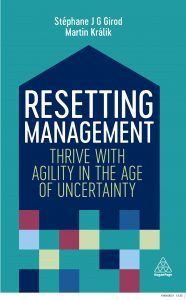

Research has demonstrated that competitive advantage in business today erodes faster than in the past. Evaluating this evolution, many studies have advised companies on how to focus on intrapreneurship and new ways of innovating to invent their next S-curve.
In these discussions, the role that organizational design plays to reinvent competitive advantage, both as a means and a source of competitive advantage itself, is overlooked. Worse, organizational design is thought to be the responsibility of HR leaders. In fact, it’s the responsibility of any senior executive, not just HR, to master its principles.
In the next decades, organizational design will be an additional source of competitive advantage if business executives reset management by making the transition from traditional and rigid management to organizational agility. Here are four principles you may want to keep in mind to thrive with agile organizational designs.
Principle #1. Be original. Many companies tend to copy their peers. But you can do better. In their time, both IBM and Procter & Gamble with Organization 2005 invented new models that no one thought was possible. By making the three-leg matrix structure fly, for instance, P&G forced all its competitors to catch up and stayed ahead for several years. Today, dealing with the constraints of digital transformation and turbulence, some companies like Haier and ING have created revolutionary organizational models for agility, defying their industries’ conventions. When designing, try to be as creative as if it were your next business proposition.
Principle #2. Master the principles of agility. In the next decades, executives will be rewarded for how well they allow their business to adapt to turbulence and to grow. These two goals require new organizational principles for agility. Organizational agility is more than doing things faster. It’s the flexibility a business gets when management can empower the workforce to innovate and improvise around the customer to adapt to unexpected changes, while giving them clear strategic goals, purpose and precise output-based KPIs to continue delivering on the strategy. It’s like giving them the destination but letting them define the roadmap. This is the competing demand between being nimble and stable. Large businesses will also need to simplify the hierarchy and bureaucracy without becoming simplistic, since what suits some divisions or countries might not suit others. This is the competing demand between being simple and complex.
Principle #3. Upgrade your capabilities for agility. Designing an organization, even for agility, continues to be about aligning structure, processes, incentives & rewards, values and people with each other and strategy. With agility, though, you might need to learn about the new shape that some of these elements take. Processes can consist of agile methods, so learning what they are without becoming a geek is crucial. Leadership becomes about being fluent in multiple leadership styles, such as leading through purpose and inspiration, empowering but running tough conversations or driving for accountability, rather than defaulting to command and control. So, learning the ins and outs of multiple styles and when to apply them is advisable too.
 Principle #4. Calibrate agility to your circumstances. Winning with organizational design is about creating the right design for your circumstances. In the turbulent home appliance industry, Haier chose a bolder form of agility than one of the big luxury brands we studied. Yet both were following the principles of agility and none used agile methods. Winning through agility is not necessarily about defaulting to agile methods. While all companies will need to be agile, they will not necessarily have to do agile.
Principle #4. Calibrate agility to your circumstances. Winning with organizational design is about creating the right design for your circumstances. In the turbulent home appliance industry, Haier chose a bolder form of agility than one of the big luxury brands we studied. Yet both were following the principles of agility and none used agile methods. Winning through agility is not necessarily about defaulting to agile methods. While all companies will need to be agile, they will not necessarily have to do agile.
Prof. Stéphane JG Girod is leading IMD professor and co-author of Resetting Management: Thrive with Agility in the Age of Uncertainty (Kogan Page).

Thinkers50 Limited
The Studio
Highfield Lane
Wargrave RG10 8PZ
United Kingdom

Thinkers50 Limited
The Studio
Highfield Lane
Wargrave RG10 8PZ
United Kingdom

Thinkers50 Limited
The Studio
Highfield Lane
Wargrave RG10 8PZ
United Kingdom
| Cookie | Duration | Description |
|---|---|---|
| LANG | 9 hours | Linkedin set this cookie to set user's preferred language. |
| nsid | session | This cookie is set by the provider PayPal to enable the PayPal payment service in the website. |
| sp_landing | 1 day | The sp_landing is set by Spotify to implement audio content from Spotify on the website and also registers information on user interaction related to the audio content. |
| sp_t | 1 year | The sp_t cookie is set by Spotify to implement audio content from Spotify on the website and also registers information on user interaction related to the audio content. |
| tsrce | 3 days | PayPal sets this cookie to enable the PayPal payment service in the website. |
| x-pp-s | session | PayPal sets this cookie to process payments on the site. |
| __cf_bm | 30 minutes | This cookie, set by Cloudflare, is used to support Cloudflare Bot Management. |
| Cookie | Duration | Description |
|---|---|---|
| l7_az | 30 minutes | This cookie is necessary for the PayPal login-function on the website. |
| Cookie | Duration | Description |
|---|---|---|
| CONSENT | 2 years | YouTube sets this cookie via embedded youtube-videos and registers anonymous statistical data. |
| _ga | 2 years | The _ga cookie, installed by Google Analytics, calculates visitor, session and campaign data and also keeps track of site usage for the site's analytics report. The cookie stores information anonymously and assigns a randomly generated number to recognize unique visitors. |
| _gat_gtag_UA_10408481_1 | 1 minute | Set by Google to distinguish users. |
| _ga_ZP8HQ8RZXS | 2 years | This cookie is installed by Google Analytics. |
| _gid | 1 day | Installed by Google Analytics, _gid cookie stores information on how visitors use a website, while also creating an analytics report of the website's performance. Some of the data that are collected include the number of visitors, their source, and the pages they visit anonymously. |
| Cookie | Duration | Description |
|---|---|---|
| NID | 6 months | NID cookie, set by Google, is used for advertising purposes; to limit the number of times the user sees an ad, to mute unwanted ads, and to measure the effectiveness of ads. |
| test_cookie | 15 minutes | The test_cookie is set by doubleclick.net and is used to determine if the user's browser supports cookies. |
| VISITOR_INFO1_LIVE | 5 months 27 days | A cookie set by YouTube to measure bandwidth that determines whether the user gets the new or old player interface. |
| YSC | session | YSC cookie is set by Youtube and is used to track the views of embedded videos on Youtube pages. |
| yt-remote-connected-devices | never | YouTube sets this cookie to store the video preferences of the user using embedded YouTube video. |
| yt-remote-device-id | never | YouTube sets this cookie to store the video preferences of the user using embedded YouTube video. |
| yt.innertube::nextId | never | This cookie, set by YouTube, registers a unique ID to store data on what videos from YouTube the user has seen. |
| yt.innertube::requests | never | This cookie, set by YouTube, registers a unique ID to store data on what videos from YouTube the user has seen. |
| Cookie | Duration | Description |
|---|---|---|
| DEVICE_INFO | 5 months 27 days | No description |
| loglevel | never | No description available. |
| m | 2 years | No description available. |
Thinkers50 Limited has updated its Privacy Policy on 28 March 2024 with several amendments and additions to the previous version, to fully incorporate to the text information required by current applicable date protection regulation. Processing of the personal data of Thinkers50’s customers, potential customers and other stakeholders has not been changed essentially, but the texts have been clarified and amended to give more detailed information of the processing activities.